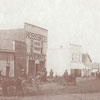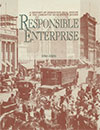Edmonton's First Land Boom
The Hudson's Bay Co. was the first land owner to undertake the large-scale subdivision and promotion of its property. On October 29, 1881, the company announced the creation of the "City of Edmonton." Their advertisement in the Edmonton Bulletin said the townsite was at the centre of the gold, coal, timber, and mineral region of the great North-West, and was surrounded by the richest wheat-producing country in the world. The most important aspect of the new townsite, it said, was that it was on the projected Saskatchewan branch of the Canadian Pacific Railway (CPR).

The Hudson's Bay Co.'s high expectations were shared by Frank Oliver, the publisher of the Edmonton Bulletin, Alberta's first newspaper. He wrote in his paper: "There is a possibility that the syndicate have decided to build the CPR via Edmonton, crossing the river here, and uniting with the H.B. Co. in building upon their property the metropolis of this far North-West. If this surmise should prove correct, and it is at least reasonable, all the booms that have taken place yet in Manitoba or elsewhere will be nothing compared to that which the tumble-down walls of Fort Edmonton will see during the next year or two."
After its advertisement appeared, the Hudson's Bay Co. called a public meeting to explain its plans and invite participation in designing certain aspects of the town. Terms of the land sales were one-third cash and the balance in two equal installments. Buyers were required to erect a building within eigh¬teen months from the date of purchase on at least every second lot. Lots were free for schools and churches.

Plan B, the subdivision that covered the southern portion of the Hudson's Bay Co. Reserve, contained 2,137 lots.
Edmonton's first legal subdivision found a ready market when offered for sale. The Edmonton Bulletin reported on February 3, 1882, that the moment the land went on sale "there was a rush for lots that would have surprised even a Winnipeg auctioneer, and in three or four days, $12,000 worth, or about 400 lots were sold subject to building conditions." The selling price averaged $32 per lot. Hudson's Bay Co. Land Commissioner Charles Brydges then assumed control of future land sales because he considered the price too low. Brydges' pricing strategy was to withhold the land from the market and to deal only with Winnipeg or Eastern Canadian investors. This approach brought immediate results when the Scottish, Ontario, and Manitoba Land Co. purchased 300 lots at $110 per lot. This sale prompted enquiries about Edmonton land from people in Toronto, London, and Hamilton. Given the rising demand, Brydges was able to raise the price as high as $250 for lots in choice locations. Even at these inflated prices, about 500 lots were sold.
The interest in Edmonton lots prompted Brydges to subdivide additional land. It was sold by public auction. The Hudson's Bay Co. auction in Winnipeg was two days of frantic activity where a bout 500 people participated in one day alone. Total sales of property during this auction amounted to between $250,000 and $300,000.
Interest dwindled in the company townsite, however, by the spring of 1882. The CPR had decided on a southern route. With the end of the boom, the Hudson's Bay Co. lost interest in their Edmonton property, as did most people who had purchased land during the boom. In Brydges' opinion: "The great bulk of the sales made at Edmonton will not be carried out. There is no railway projected at present to Edmonton, and until that is done the sale if lots will not amount to anything."
Frank Oliver, however, disagreed. In the Edmonton Bulletin on June 17, 1882, he wrote that:
Outside of the boom the prospects of Edmonton are second to those of no place in Manitoba or the North West except Winnipeg. The boom as far as it has gone left a large amount of money here of which every dollar has been invested and if it has burst utterly and lots can now be sold in Winnipeg for a cent a piece that matter will concern very few people here. They have not been in the real estate business. The boom started suddenly and went ahead too rapidly for them to invest.
The collapse of Edmonton's first land boom did not stop the subdivision of land. It simply shifted the activity back to the river lots in the east where the town of Edmonton had begun.
This article is extracted from John Gilpin, Responsible Enterprise: A History of Edmonton Real Estate & the Edmonton Real Estate Board. (Edmonton: Edmonton Real Estate Board, 1997). The Heritage Community Foundation and the Alberta Real Estate Foundation would like to thank John Gilpin and the REALTORS® Association of Edmonton for permission to reproduce this material.





